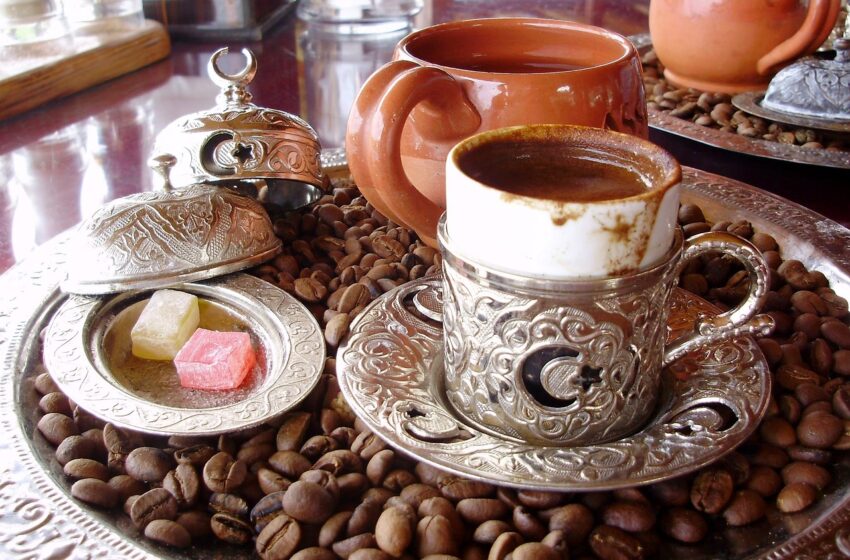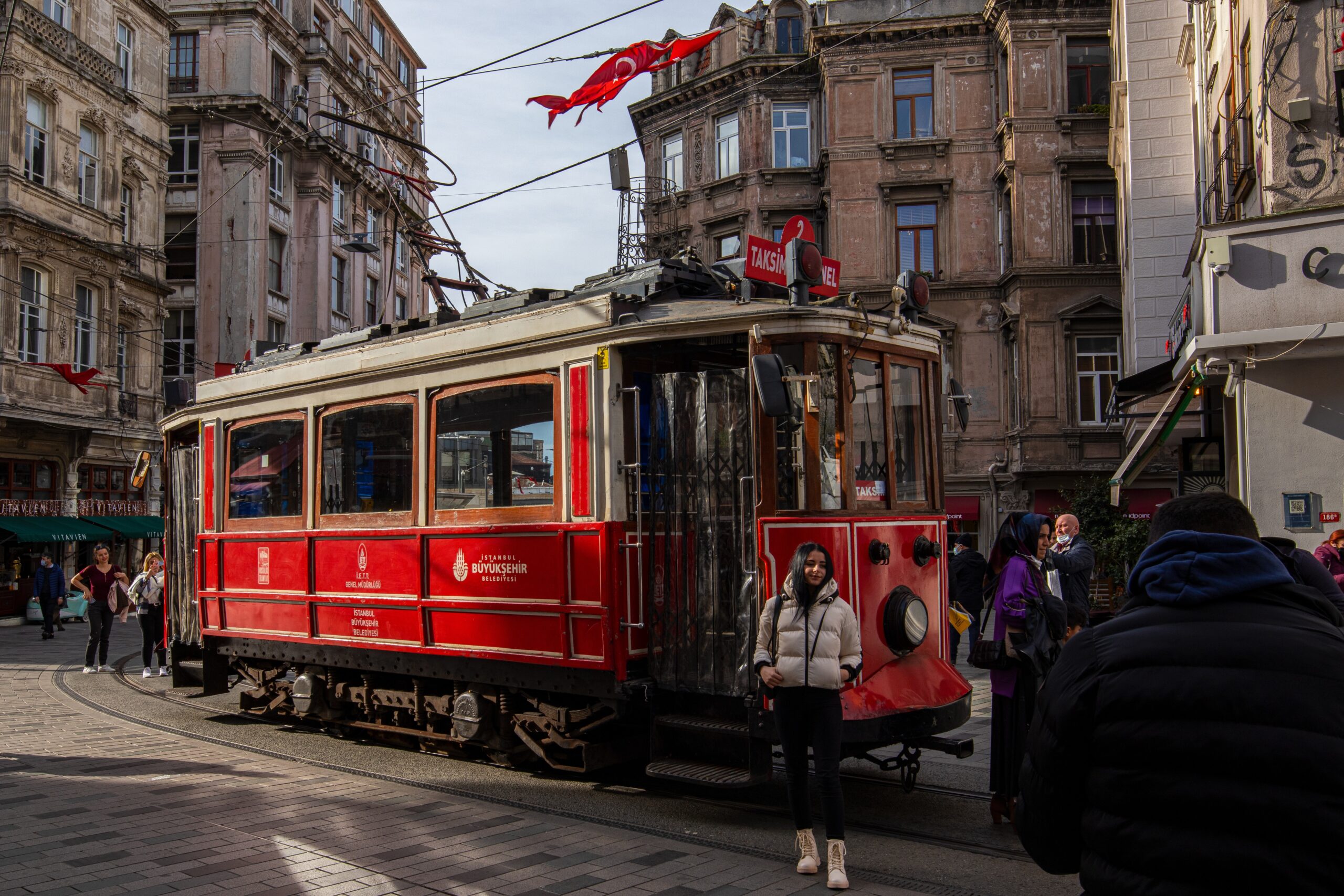Traditional Turkish coffee has a bitter, intense flavor that resembles espresso, but is unfiltered. Because of the differences in the brewing process, Turkish coffee includes coffee grinds in it. Thus the taste of Turkish coffee is a bit different than regular coffee. Traditional Turkish coffee is unfiltered. There will be coffee grinds at the bottom of the cup. As you drink from the small cups try to avoid swallowing them. So what does Turkish coffee taste like afterall? Is it any different than regular coffee? Let’s dive into it.
How is Turkish coffee different from regular coffee?
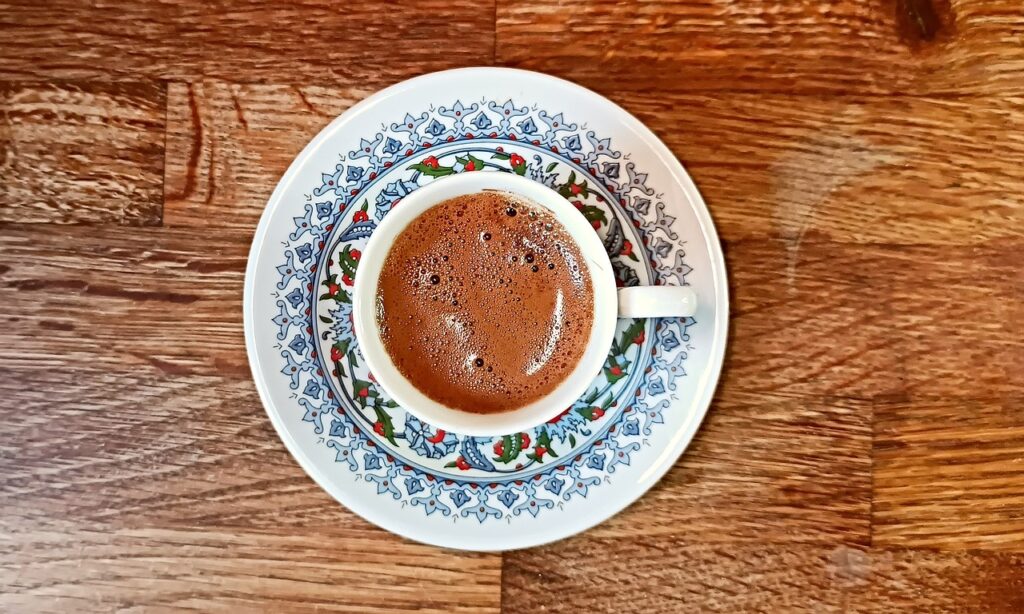
Traditional Turkish coffee has a more bitter, denser taste than regular coffee. “Regular coffee” is a very broad term, as there are simply so many types of coffee. For the sake of this post, let’s consider black filter coffee from Starbucks as “regular coffee”. So in other words, American-style filtered black coffee. Both traditional Turkish coffee and regular filter coffee are ground coffee. They are both made from arabica beans. They both have a lot of health benefits. However, unlike regular coffee, traditional Turkish coffee has a less watery and bold flavor. Turkish coffee will also have a more unfiltered taste, due to having residue of fine coffee grounds in the cup.
How is Turkish coffee made? (How is Turkish coffee brewed?)
Traditional Turkish coffee is made by mixing cold water and fine powder coffee grinds in a special small pot, and slowly heating until ready. Some types of coffee are brewed with hot water. Traditional Turkish coffee is brewed with cold water in a special pot. The heat source is often a gas stove, and sometimes heated sand in touristic places. In some countries, Turkish coffee might have different preparation methods. However, the traditional brewing method is applying low heat and slowly brewing in copper pots. These special pots, usually copper pots are called “cezve” in Turkish. A small amount of coffee, typically less than a tablespoon is placed in the Turkish coffee pot. Later, the coffee is mixed with cold water, and if preferred, sugar. The size of the cup determines the amount of cold water. Since traditional Turkish coffee is served in demitasse cups, that’s about 2-3 oz (60-90ml) of water. According to the traditional method, the coffee, cold water, and sugar (optional) are mixed before heating. Medium heat is applied in the first few minutes, then low heat until cooked. Once the thick foam starts soaring, the pot is removed from the heat source and served. The pot should never be left alone as the thick foam can boil over at any time. Once served, you can drink it right away or let it rest for a minute. Since traditional Turkish coffee is served before boiling, it won’t be too hot. Here’s a table to help you get started:
| Amount of Coffee | Amount of Water | Amount of Sugar | |
| One person serving | 0.2-0.4 oz (6-12 ml) | 2-3 oz (60-90 ml) | 0-0.2 oz (0-6 ml) |
| Two people serving | 0.4-0.8 oz (12-24 ml) | 4-6 oz (120-180 ml) | 0-0.4 oz (0-12 ml) |
| Three people serving | 0.6-1.2 oz (18-36 ml) | 6-9 oz (180-270 ml) | 0-0.6 oz (0-18 ml) |
| Four people serving | 0.8-1.6 oz (24-48 ml) | 8-12 oz (240-360 ml) | 0-0.8 oz (0-24 ml) |
Note: Traditional Turkish coffee can be brewed with or without sugar. If you like your coffee sweet, add as much sugar as you like. Many people in Turkey drink with and without sugar. How much sugar you put inside has little to do with traditional preparation methods. It’s completely fine if you like your coffee bitter, that’s how many people drink in Turkey too. It is also traditional to eat something sweet next to Turkish coffee, such as Turkish delight.
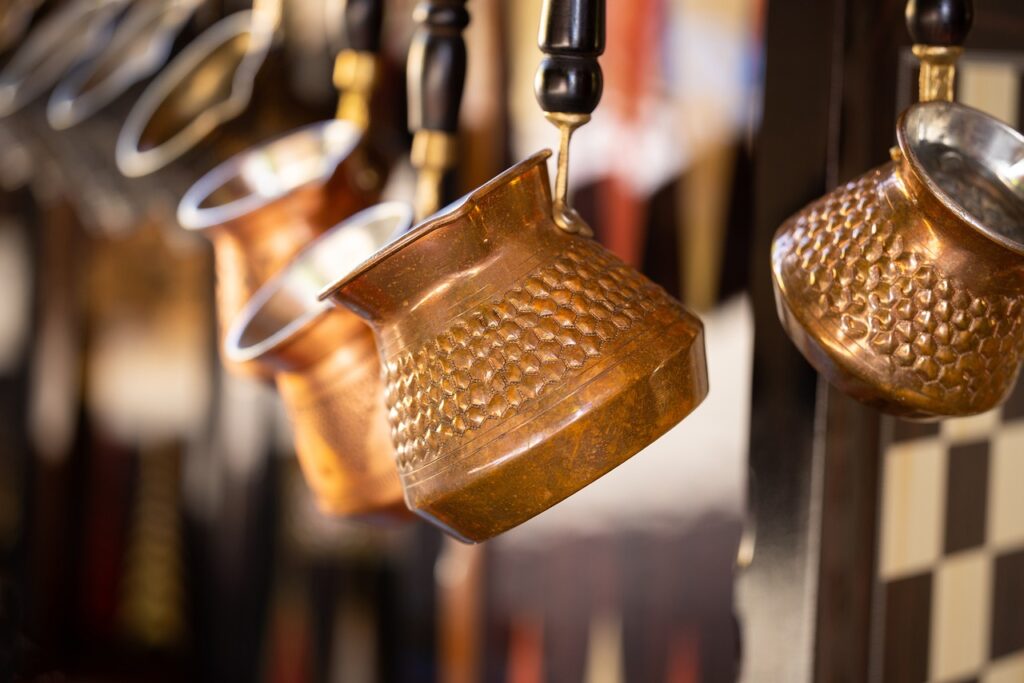
This is “cezve”, the traditional Turkish coffee pot. You can find similar copper pots used in the traditional brewing method online.
How is Turkish coffee different? What is so special about Turkish coffee?
Traditional Turkish coffee is different because of its unique brewing method and serving style. The traditional brewing method of Turkish coffee with cold water and low heat sets Turkish coffee apart. The type of coffee beans used is arabica beans, so that’s the same as regular coffee. The fine powder coffee grinds accumulating in the bottom of the cup creates a unique flavor. This creates a different taste, an unfiltered, thick coffee experience. Another huge difference is the way of serving and the culture around it. Traditional Turkish coffee is more than just a drink, it is an inseparable part of Turkish culture. This specialty coffee traditionally is served in tiny cups, accompanied by Turkish delight and a glass of water. The coffee grinds at the bottom of the cup are even used for fortune-telling. It is even a popular activity in Turkey to go to a fortune teller and let them “read your coffee”. Similar to reading tea leaves.
How is Turkish coffee served?
Traditional Turkish coffee is served in tiny cups, similar to demitasse cups or espresso cups. You can use a standard espresso cup to serve Turkish coffee. Main differences between serving regular coffee and Turkish coffee:
- Turkish coffee is served with a sweet treat, typically Turkish delight
Although Turkish coffee can be served with any sweet, Turkish delight will be the most traditional choice. The Turkish delight is eaten before or during drinking, to sweeten the experience. Turkish coffee can also be served with baklava or any sweet treat.
- Turkish coffee is served with a glass of water
A glass of water is served next to the coffee for washing mouth before and after drinking. Many people think water is mainly for washing the mouth after drinking. This is because of the coffee grinds accumulating at the bottom of the cup. However, it is traditionally served to cleanse the mouth for a more intense Turkish coffee experience.
- Traditional Turkish coffee is served at a sub-boiling temperature
Turkish coffee is served right before it boils. This is made on purpose to maximize the thick foam of Turkish coffee. Right before it boils, the coffee will start soaring in the small pot. This produces a thick foam. To be able to brew a delicious cup of Turkish coffee with thick foam is considered a talent. The thicker the foam, the better the experience. It is a sign of success. Also, since Turkish coffee is served before boiling, it typically won’t be too hot. Most people can drink it right away.
- It is served in a small Turkish coffee cup, similar to an espresso cup
A typical Turkish coffee cup looks like an espresso cup, but usually with a wider bottom. It is typically not transparent, and not made of glass. Just like demitasse cups, a Turkish coffee cup will also be made of porcelain.
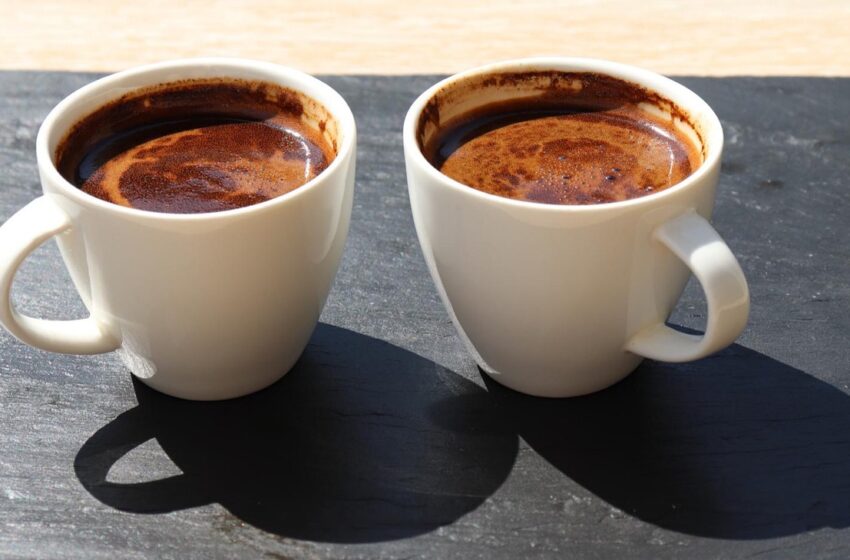
This is a typical Turkish coffee cup. Similar to an espresso cup.
How is Turkish coffee made on sand?
A metal tray full of sand is heated from the bottom with a gas or electric stove and Turkish coffee is brewed on hot sand in copper pots. This brewing method has been around for centuries during the Ottoman Empire. Even though this method is often attributed to Turkey, it’s not as common in Turkey as you’d think. This method was probably more common in the Ottoman Empire. Also, it is likely that it was practiced more often in the Middle East where actual deserts are. The Ottoman Empire controlled a vast territory that covered most of the Middle East. So it could have originated anywhere in the Ottoman Empire.
The heat source is typically a gas or electric stove placed under the tray with sand. A metal tray is placed on top of the heat source and filled with sand. The small pot, typically made of copper, called “cezve” is used for brewing. Unlike a regular stove, hot sand envelops the entire pot and applies heat evenly. This will create a richer, fuller taste and a delicious, thick foam. The brewer will typically make circles with the “cezve” in the sand to apply heat to all sides. As the coffee starts boiling, they’ll pour the thick foam into the small cups. They will first distribute the foam to multiple cups and then pour the rest of the coffee.
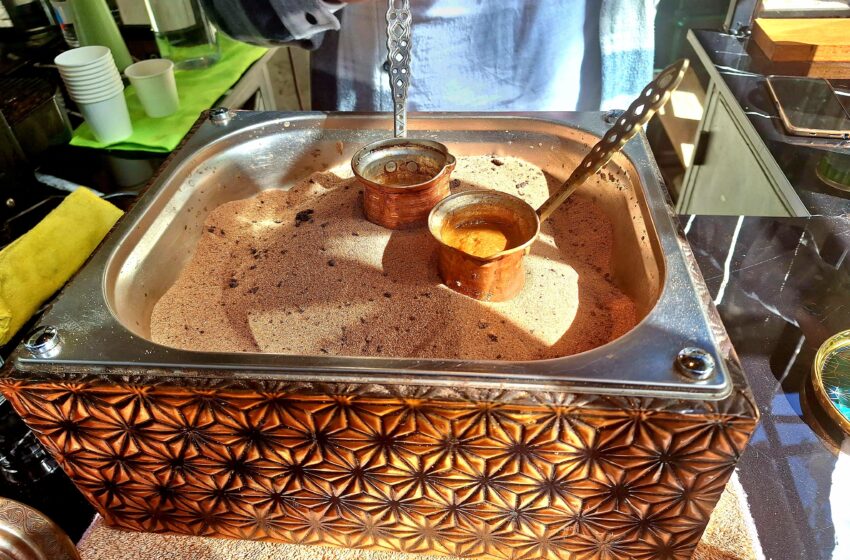
This is the famous Turkish delight, invented hundreds of years ago in the Ottoman Empire. Turkish delight is often eaten next to Turkish coffee.
Is Turkish coffee stronger than espresso?
Traditional Turkish coffee has slightly less caffeine amount than espresso per serving, about 3 mg per ounce. The difference is not huge, but it is there. If you drink the same amount of Turkish coffee and espresso, you would be ingesting higher amounts of caffeine. So no, Turkish coffee isn’t stronger than espresso. They’re either the same depending on the brand or espresso is slightly stronger.
Is Turkish coffee healthier than regular coffee?
Turkish coffee is not filtered like most types of coffee, thus has higher levels of chlorogenic acid, which are good for you. Chlorogenic acids are natural antioxidants found in high caffeine content and have many health benefits. Such health benefits include improved cholesterol levels, blood sugar, inflammation, and even blood pressure. Unlike most types of coffee, Turkish coffee is served unfiltered due to to fine grind. Turkish coffee is very fine, thus the tiny bits of ground left in the cup don’t bother most coffee lovers. To learn more about chlorogenic acids and its health benefits, check out the Wikipedia article on the topic. However, it is also often considered healthier to filter your coffee. Chlorogenic acids are healthy and you get more of it with Turkish coffee. However, you also get more, unfiltered chemicals like kahweol and cafestol which may not be too healthy. These chemicals often don’t make it past the coffee filter, or less of it does. Thus Turkish coffee may not be the healthiest choice to drink on a regular basis. Drinking it once in a while won’t kill you, as millions of people drink cups of it every day. However, it might be healthier to stick to your filtered black coffee and drink Turkish coffee as a treat. And if you’re feeling naughty, maybe even have a little Turkish delight next to it 🙂
How old is the Turkish Coffee?
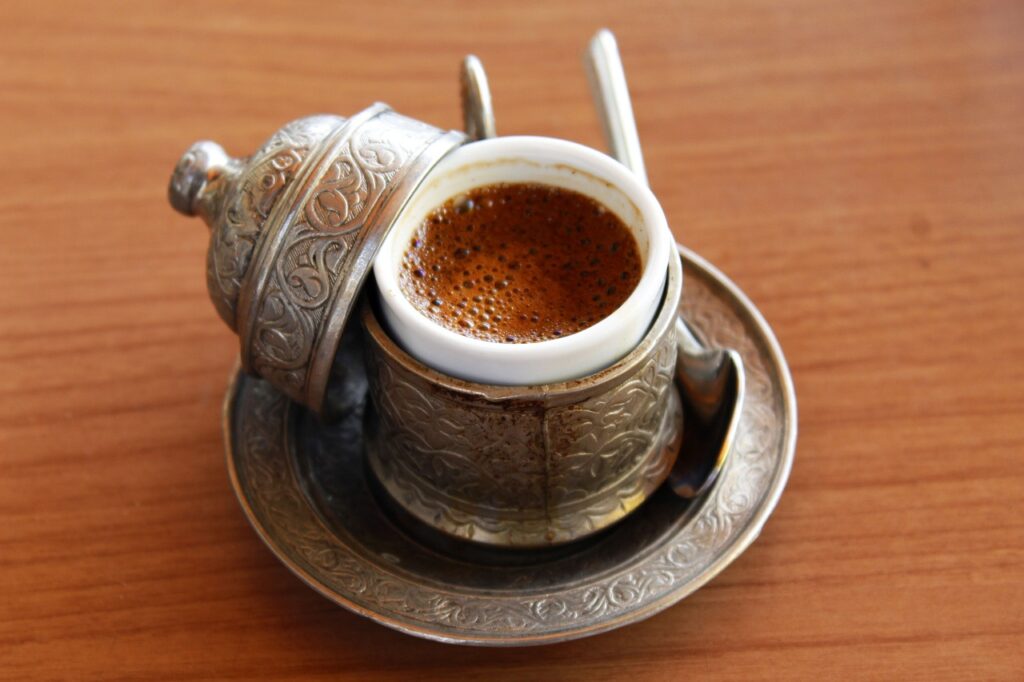
Turkish coffee’s roots go back to the 16th century Ottoman Empire. Turks have been drinking coffee since long before they have been drinking tea. The history goes back to the 16th century Ottoman Empire when the governor of Yemen brought coffee to Istanbul. Ozdemir Pasha, the governor of Yemen in the Ottoman Empire, brought this delicious drink to the capital. Soon after the arrival of coffee, it quickly became an incredibly popular beverage. The first coffee shop opened in Tahtakale, Istanbul in 16th century. In a decade, coffee became the favorite drink of everyone from Sultans to the common people in the Ottoman Empire. By the time 17th century arrived, it was ubiquitous in the Ottoman Empire. Together with the Turkish delight, traditional Turkish coffee became an inseparable duo in the Ottoman Empire. Even today, many places offer Turkish delight with Turkish coffee. Interestingly, tea wasn’t so popular in the Ottoman Empire. Turkish tea, contrary to the common misconception, doesn’t have roots in the Ottoman Empire. Turkish tea, unlike Turkish coffee became popular in the last century. Drinking coffee, however, has roots deep into the golden ages of the Ottoman Empire.
Importance of Coffee in Turkish Culture
Turkish coffee is an integral part of Turkish culture. It is so much that even the word for “breakfast” has the word “coffee” in Turkish. In the Turkish language, the word for breakfast is “kahvaltı”. “Kahvaltı” is short for “kahve altı” which literally means “under coffee”. What this really means is that breakfast was merely an excuse to drink coffee 😊 Even though today, breakfast is a huge part of Turkish culture, it wasn’t always the case. Today, Turkish tea is associated more with Turkish breakfast. However, it wasn’t always like this during the Ottoman Empire. While you’re at it, if you wonder what is the best Turkish tea check out our article on this topic. We dive deep into different tea brands and comparisons!
Talking about “under coffee” aka “breakfast”: you simply MUST try Turkish breakfast when you’re in Istanbul. If you wonder what Turkish breakfast is, read our article on this topic: Turkish Breakfast: An Absolute Feast for Your Eyes and Stomach. But don’t just finish there, also read our article on Top 10 Istanbul Food Tips to improve your knowledge! And while you’re reading, check out our guide on 15 Must Try Street Foods in Istanbul!
Conclusion
Traditional Turkish coffee is a delicious, unique beverage with roots deep into the 16th century Ottoman Empire. There is a whole culture around it, and with its unique brewing method, it stands out from other types of coffee. Try Turkish coffee on sand, with and without sugar, and with Turkish delight. Try drinking it with a local friend, let them tell your fortune from a cup of coffee, and create unforgettable memories. After all, as we say in Turkey, “a cup of coffee creates 40 years of memory”.

